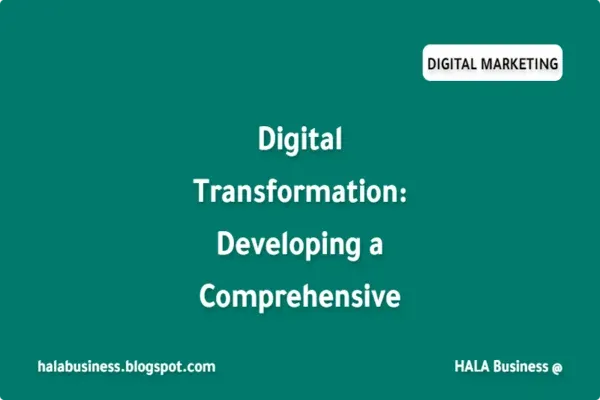The world of business is constantly evolving, and in order to stay competitive, companies must be proactive in their approach to digital transformation.
This process involves integrating technology into all aspects of a business, from operations to customer service, in order to improve efficiency and drive growth.
However, implementing a successful digital transformation strategy requires careful planning and a thorough understanding of the organization's goals and capabilities.
Digital Transformation: A Necessity for Modern Businesses
In today's fast-paced, digital world, companies that fail to adapt risk being left behind. The rise of new technologies such as artificial intelligence, the Internet of Things, and 5G networks has created new opportunities for businesses, but it has also increased the pressure to innovate and stay ahead of the competition.
A comprehensive digital transformation strategy can help organizations take advantage of these opportunities, improve their operations, and achieve long-term success.
Understanding Digital Transformation
Digital transformation is more than just implementing new technology; it's about fundamentally changing the way a business operates.
This process involves rethinking the organization's processes, culture, and structure in order to better leverage technology and drive growth. In order to develop a successful digital transformation strategy, it's important to have a clear understanding of the organization's goals and capabilities.
Identifying Opportunities for Improvement
The next step in developing a comprehensive digital transformation strategy is identifying areas where technology can improve the organization's operations.
This may include automating repetitive tasks, streamlining communication and collaboration, or improving customer service. It's important to involve key stakeholders in this process to ensure that the organization's goals and capabilities are taken into account.
Building a Roadmap
Once opportunities for improvement have been identified, it's time to start building a roadmap for digital transformation.
This should include a clear timeline and milestones, as well as specific goals and objectives. It's also important to consider the organization's budget and resources, as well as any potential risks or challenges that may arise.
Implementing the Strategy
Implementing a digital transformation strategy requires a combination of technical expertise and organizational change management.
It's important to work closely with IT and other key stakeholders to ensure that the new technology is integrated seamlessly into the organization's operations.
This may include training employees, developing new processes and procedures, and building a culture that embraces change.
Measuring Success
Finally, it's important to measure the success of the digital transformation strategy. This should include both quantitative and qualitative metrics, such as increased efficiency, improved customer satisfaction, and cost savings.
Regularly reviewing the organization's progress and making adjustments as needed will ensure that the digital transformation strategy remains relevant and effective over time.
Embracing Automation
One of the key elements of digital transformation is automation. Automation allows companies to streamline their operations and improve efficiency by automating repetitive tasks, such as data entry and customer service.
This can free up employees to focus on more complex and value-added tasks, such as problem-solving and innovation. Additionally, automation can lead to cost savings, improved accuracy, and increased productivity.
Leveraging Cloud Computing
Cloud computing is another important aspect of digital transformation. Cloud-based services allow companies to store and access data remotely, which can improve collaboration and flexibility.
This can also lead to cost savings, as companies can avoid the upfront costs of purchasing and maintaining expensive hardware.
Additionally, cloud-based services can improve scalability, enabling companies to quickly adjust to changing business needs.
Using Big Data and Analytics
Big data and analytics are also crucial for digital transformation. These technologies allow companies to collect, store, and analyze large amounts of data in real-time.
This can provide valuable insights into customer behavior, market trends, and business performance. By leveraging big data and analytics, companies can improve decision-making, gain a competitive advantage, and improve customer service.
Prioritizing Cybersecurity
In the digital age, cybersecurity is more important than ever. As companies become more reliant on technology, they are also becoming more vulnerable to cyberattacks.
This can lead to data breaches, loss of revenue, and damage to reputation. To protect against these threats, companies must prioritize cybersecurity in their digital transformation strategy.
This includes implementing robust security measures, such as firewalls, intrusion detection systems, and encryption. It also includes educating employees on how to recognize and respond to cyber threats.
Fostering a Digital Culture
Finally, it's important to foster a digital culture within the organization. This means encouraging employees to embrace technology, be open to change, and continuously learn and adapt.
It also means promoting a culture of innovation and experimentation, where employees are encouraged to test new ideas and take risks.
By fostering a digital culture, companies can create an environment that is conducive to digital transformation and long-term success.
Conclusion:
Digital transformation is a complex and ongoing process that requires a comprehensive strategy. By embracing automation, leveraging cloud computing, using big data and analytics, prioritizing cybersecurity, and fostering a digital culture, companies can successfully integrate technology into all aspects of their operations, improve efficiency, and drive growth.
However, it's important to remember that digital transformation is not a one-time event; it requires a continuous effort to stay ahead of the competition and adapt to the ever-changing business landscape.



0 Comments